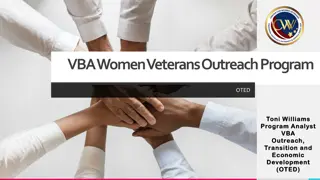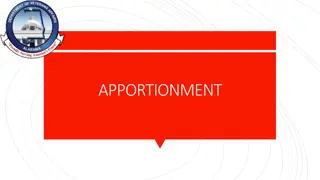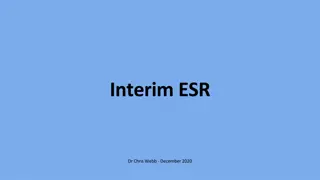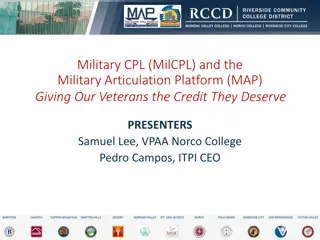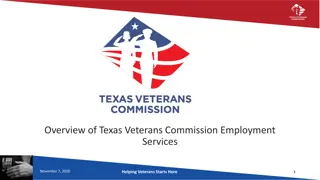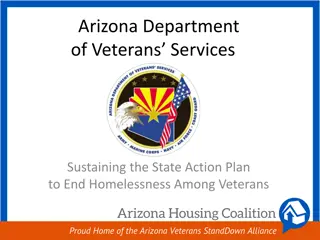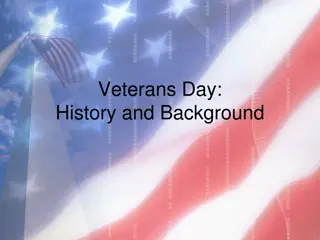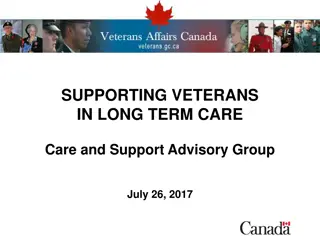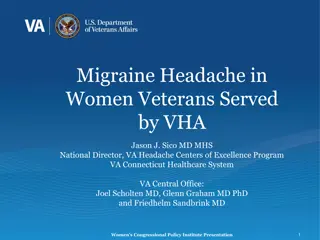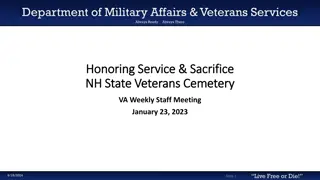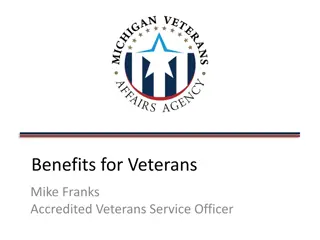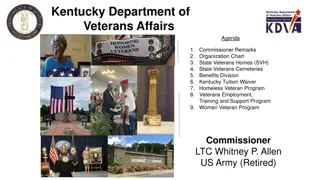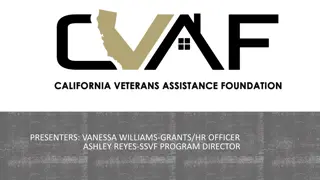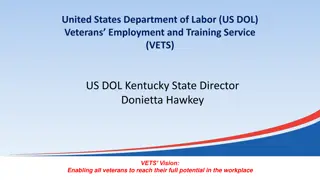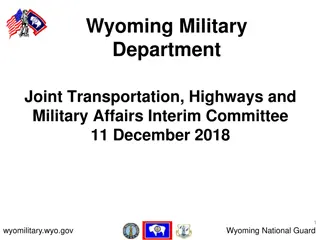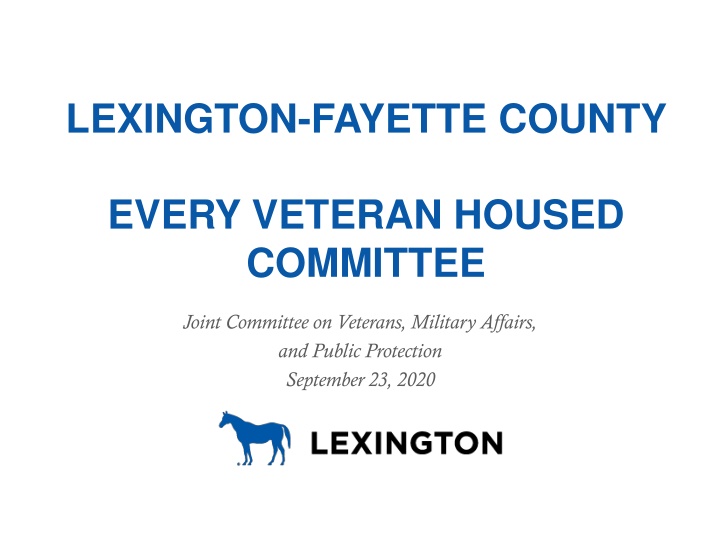
Lexington-Fayette County Every Veteran Housed Committee Details
"Learn about the Lexington-Fayette County Every Veteran Housed Committee, its mission to end veteran homelessness, continuum of care tasks, and community involvement. Find out about key members and initiatives to support veterans." (289 characters)
Download Presentation

Please find below an Image/Link to download the presentation.
The content on the website is provided AS IS for your information and personal use only. It may not be sold, licensed, or shared on other websites without obtaining consent from the author. If you encounter any issues during the download, it is possible that the publisher has removed the file from their server.
You are allowed to download the files provided on this website for personal or commercial use, subject to the condition that they are used lawfully. All files are the property of their respective owners.
The content on the website is provided AS IS for your information and personal use only. It may not be sold, licensed, or shared on other websites without obtaining consent from the author.
E N D
Presentation Transcript
LEXINGTON-FAYETTE COUNTY EVERY VETERAN HOUSED COMMITTEE Joint Committee on Veterans, Military Affairs, and Public Protection September 23, 2020
Lexington-Fayette County Every Veteran Housed Committee Definition of Veteran For this purpose: Any person who served on active duty in the armed forces, regardless of how long they served or the type of discharge they received.
Lexington-Fayette County Every Veteran Housed Committee Order of the Day Lexington-Fayette Urban County Government, Office of Homelessness Prevention and Intervention Polly Ruddick, Director Lexington Veteran Affairs Health Care System Stephanie Gibson, Homeless Programs Manager Volunteers of America, Mid-States Anne Vandervort, Senior Program Director
Lexington-Fayette County Every Veteran Housed Committee Continuum of Care HEARTH Act Passed in 2009 Codified into law a designated single Continuum of Care as the planning body and coordinator of the entire homeless crisis response system Coordinate the implementation of a housing and service system that includes outreach, engagement, and assessment, shelter, housing, and supportive service, prevention strategies Hold community, board, and stakeholder meetings Develop committees, subcommittees or workgroups Establish performance targets, monitor, take action Evaluate Emergency Solutions Grant and Continuum of Care programs Develop Coordinated Entry process Designate and operate a Homelessness Management Information System (HMIS) Ensure participation from providers, stakeholders, the public Conduct LexCount (annual Point In Time Count) Conduct annual gap analysis Provide information for Fayette County s Consolidated Plan
Lexington-Fayette County Every Veteran Housed Committee Every Veteran Housed Committee Formed in July 2014 Mayor Gray s acceptance of HUD s Mayors Challenge to End Veteran Homelessness Goal Continuously improve the system in order to meet every need of our veteran population. We will remain steadfastly committed to continuing a collaborative community systematic, data-driven approach, never letting our guard down which can result in letting our veterans down. Mission Fayette County will have a veteran housing system that makes episodes of homelessness rare, brief, and non-reoccurring. Meeting Schedule Core Response Providers, bi-weekly Full Committee, bi-monthly
Lexington-Fayette County Every Veteran Housed Committee Core Response Team Catholic Action Center Community Action Council Hope Center Lexington-Fayette County Housing Authority Lexington Veteran Affairs Health System Lexington-Fayette Urban County Government, Office of Homelessness Prevention and Intervention Mountain Comprehensive Care Center St. James Place The Salvation Army, Lexington Volunteers of America, Mid-States
Lexington-Fayette County Every Veteran Housed Committee Supportive Partners Bluegrass Care Navigators Bluegrass Community and Technical College Bluegrass Community Health Center Catholic Charities Diocese of Lexington Fayette County Sheriff Goodwill Industries of Kentucky Chrysalis House Lady Veterans Connect Department of Labor, Veteran Employment Division Lexington Police Department Eastern State Hospital LexTran Fayette County Department of Community Based Services Fayette County Public Schools God s Pantry GreenHouse17 HealthFirst Bluegrass Jubilee Jobs of Lexington Parks and Recreation, LFUCG Kentucky Habitat for Humanity Legal Aid of the Bluegrass University of Kentucky Medical Center Lexington Fair Housing Council Lexington Fayette County Health Department Lexington Fire Department Lexington Rescue Mission LFUCG Grants and Special Programs LFUCG Social Services Natalie s Sisters Nathaniel United Methodist Mission National Alliance on Mental Illness New Beginnings, Bluegrass New Life Day Center New Vista Office of Vocational Rehabilitation One Parent Scholar House Shepherd s House Social Security Administration United Way of the Bluegrass Urban League of Lexington-Fayette County Welcome House of Northern Kentucky
Lexington-Fayette County Every Veteran Housed Committee Veteran Homeless Response System Shelter or Unsheltered Permanent Housing Housing First Emphasis HUD VASH Street Outreach, Unsheltered Within 24 hours, names are sent to EVH Committee Hope Center Support Services for Veteran Families Vet Choice Transitional Housing The Salvation Army St. James Place GPD Veteran Section 8 Vouchers Hope Center GPD Catholic Action Center VA Contract Beds Public Housing Units (Veteran Preference) Emergency Family Housing Program HUD Continuum of Care Projects Housing First Emphasis Day Centers All veterans offered Permanent Housing First and enter Transitional Housing by choice. TH residents continuously offered exits to Permanent Housing.
Lexington-Fayette County Every Veteran Housed Committee Criteria for Effectively Ending Veterans Homelessness The Community has identified ALL Veterans experiencing homelessness The community has used coordinated outreach, multiple data sources, and other methods, to identify, enumerate, and engage all Veterans experiencing homelessness, including Veterans who experience chronic homelessness and Veterans who are unsheltered, as well as Veterans in shelters, Grant and Per Diem programs, other VA residential programs, other transitional housing programs, etc.. The community provides shelter immediately to ANY Veteran experiencing unsheltered homelessness who wants it. The community also has the capacity to immediately offer and provide some form of shelter to any Veteran experiencing unsheltered homelessness in the community who wants it, while assisting the Veteran to swiftly achieve permanent housing. Access to shelter is not contingent on sobriety, minimum income requirements, lack of criminal record, or other unnecessary conditions. The community provides service-intensive transitional housing only in LIMITED INSTANCES. When transitional housing is provided to a Veteran, priority is placed on using it as a short-term option while working on a permanent housing solution. That may include: 1) using it as bridge housing for Veterans who are provided with permanent housing assistance but will need a place to stay while a unit is located, or 2) providing Veterans with a place to stay while they attempt to quickly find a permanent housing option for themselves. The community provides longer-term service- intensive transitional housing only when Veterans are offered a choice of a permanent housing intervention, including HUD-VASH, SSVF, or similar assistance, but instead choose to enter a transitional housing program to receive specialized services, such as recovery supports, prior to moving into permanent housing. Further, Veterans who choose to enter service-intensive transitional housing are provided with ongoing opportunities to express a preference for, to request, and to access a permanent housing intervention instead, through an at-least-monthly review of their individualized service and housing plans and their desired outcomes for services and housing. The community has capacity to assist Veterans to SWIFTLY move into permanent housing. The community has identified a permanent housing intervention for all Veterans known to be experiencing homelessness, including those Veterans who have chosen to enter transitional housing, and are able to assist Veterans to move into their permanent housing quickly and without barriers to entry, using Housing First principles and practices. The community has resources, plans, partnerships, and SYSTEM CAPACITY in place should any Veteran become homeless or be at risk of homelessness in the future. The community has resources, plans, and system capacity in place for identifying and addressing the housing and services needs of: 1) Veterans entering or returning to homelessness, and 2) Veterans at risk of homelessness. That means: a) The community is routinely using multiple data sources and conducting comprehensive outreach and engagement efforts to identify and assist homeless and at-risk Veterans and to understand where Veterans are entering the system. b) The community has an adequate level of resources and the capacity to provide appropriate services that will, whenever possible, prevent homelessness for at-risk Veterans. c) The community has an adequate level of resources and appropriate plans and services in place to continue to assist Veterans to swiftly move into permanent housing and to promote the long-term housing stability of all Veterans who have entered permanent housing.
Lexington-Fayette County Every Veteran Housed Committee Benchmarks for Effectively Ending Veterans Homelessness A. Chronic and long-term homelessness among Veterans has been ended. The community has no Veterans experiencing chronic or long-term homelessness, with the rare exceptions of: 1) Any Veteran experiencing chronic or long-term homelessness who has been identified and offered an available permanent housing intervention, but who has not yet accepted; 2) Any Veteran experiencing chronic or long-term homelessness who has been offered an available permanent housing intervention, but has declined and instead chosen to enter a transitional housing program in order to appropriately address a clinical need, such as treatment and services for homeless Veterans with substance use disorders or other mental health disorders, Safe Haven-like services for chronically homeless Veterans, or recuperative care for homeless Veterans post-hospitalization. Unless otherwise indicated, chronically homeless and long-term homeless Veterans entering GPD-SITH programs are assumed to be doing so to accomplish a clinical need. Note: Veterans who have chosen to enter GPDSITH programs to access generalized case management or job training are not included within this exempted group. Federal agencies will not be asking for detailed or personalized information regarding such exemptions, such as official confirmation of clinical needs. 3) Any Veteran that has accepted a permanent housing intervention but is still actively in the process of identifying, securing, or moving into a unit. It is important to note that Veterans are included within this exception only for the first 90 days after acceptance of the permanent housing intervention. The community continues to outreach to any Veterans experiencing long-term homelessness that have not yet accepted an offer of a permanent housing intervention and continues to offer an available permanent housing intervention to those Veterans at least once every two weeks. The community should be prepared to discuss the current status of Veterans in the exemption categories. Note: For the purposes of this benchmark, the time a Veteran spends in transitional housing is included in the calculation of whether that Veteran is experiencing long-term homelessness. B. Veterans have quick access to permanent housing. The community has a system in place to connect Veterans experiencing homelessness to permanent housing in an average of 90 days or less, measured from the day they are identified as experiencing homelessness to the day they enter permanent housing (with the exceptions described below). The calculation of this average should include all Veterans who entered permanent housing in the past three months, with two rare exceptions: 1) For any Veteran who was identified and offered a permanent housing intervention, but did not initially accept the offer, the calculation of the average should only include the time from when they accepted the intervention until they moved into housing; and 2) Any Veteran who was offered a permanent housing intervention but declined and has instead chosen to enter service-intensive transitional housing, whether to address a clinical need or not, prior to moving to a permanent housing destination should not be included. Offers must be documented through a transparent, coordinated process within the homelessness service system so that a refusal of permanent housing intervention and the Veteran s choice to enter service-intensive transitional housing is easily verifiable. Note: Communities seeking federal confirmation can document any special circumstances in their local context, such as their local housing market, that should be considered in review of their achievement of this benchmark. However, communities should do everything possible to streamline the delivery of housing assistance and housing search processes to make this timeframe as short as possible. For example, some communities have reduced their community-wide average to as short as 30 days. As communities continue to innovate and improve the delivery of housing assistance, we will continue to review the timeframe used for this benchmark. C. The community has sufficient permanent housing capacity. The number of Veterans exiting homelessness and moving into permanent housing is greater than or equal to the number of Veterans entering homelessness. Note: In cases where the community has very small numbers of Veterans experiencing homelessness, the number of Veterans entering homelessness may, at times, temporarily exceed the number of Veterans placed into permanent housing. Even in these cases, however, the long-term trend must still be consistent with reducing or preventing increases in the number of Veterans experiencing homelessness. D. The community is committed to Housing First and provides service-intensive transitional housing to Veterans experiencing homelessness only in limited instances. The number of Veterans experiencing homelessness who enter service-intensive transitional housing is significantly less than the number of Veterans entering homelessness.
Lexington-Fayette County Every Veteran Housed Committee Current Benchmark Data last 90 days (COVID-19) Chronic and long-term homelessness among Veterans has been ended. No, in the last 90 days, Fayette County has identified 2 chronic or long-term Veterans in which permanent housing has not been offered in the last 14 days. Veterans have quick access to permanent housing. Yes, households are re-homed on average within 6 days. The community has sufficient permanent housing capacity. Yes, Fayette County permanently housed 29 households in the last 90 days, while only identifying 22 new households. The community is committed to Housing First and provides service-intensive transitional housing to Veterans experiencing homelessness only in limited instances. Of those 22 newly identified Veterans, only 5 selected to access a service-intensive transitional housing program.
Lexington-Fayette County Every Veteran Housed Committee Department of Veteran Affairs VA Homeless Program Build a Rapport Assessment Wrap Around Services Inpatient/Outpatient Services, In Home Aid Services, Fiduciary, Community Resources, Advocacy Linking to Housing Programs HUD-VASH, GPD, Contract Housing, Community Housing Intensive Case Management Services Justice Outreach Services Homeless Call Center Community Partnerships Project CHALENG (Community Homelessness Assessment, Local Education and Networking Groups) Veteran Feedback
Lexington-Fayette County Every Veteran Housed Committee Volunteers of America, Mid-States Supportive Services for Veteran Families Grant funded by Department of Veteran Affairs. Promotes housing stability among very low-income Veteran families who reside in or are transitioning to permanent housing. Provides intensive case management and assistance to obtain VA benefits and other public benefits including: o Vocational rehabilitation counseling o Educational assistance o Healthcare services o Daily living services o Personal financial planning o Transportation o Income support services o Childcare o Housing counseling o Other supportive services including some financial assistance Eligibility o Veteran status o Homelessness status o Income
Lexington-Fayette County Every Veteran Housed Committee Volunteers of America, Mid-States CARES Act Funding In response to COVID-19 health pandemic First round o 53% of grant awards (May 2020-August 2020) Second round o 100% of grant awards (January 2021-September 2021)
Lexington-Fayette County Every Veteran Housed Committee Volunteers of America, Mid-States Emergency Housing Assistance/Expanded Services Expanded services o Allowance for hotels to avoid congregate settings o Promote social distancing in shelters and other programs o Rental and landlord relations o Ability to reach low-visibility veteran o Outreach opportunities and community partnerships o Healthcare Navigators

